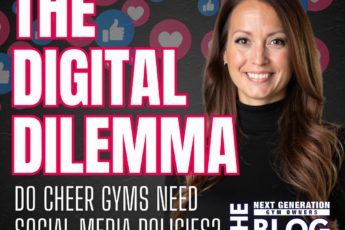Many years ago I abandoned the idea of following an industry standard of any kind. It turned out, many things that were standard in all star cheer weren’t in the best interest of my gym or the customers I serve. Yet, today when I see posts on Facebook, coaches and owners alike use “industry standard” as the reason they choose to do certain things. Let me provide some examples:
Private lessons
While I completely agree we need to pay coaches what they’re worth, we should be doing that every hour they’re working – not just during private lessons. So then why should private lessons be paid differently?
We owned a healthy fast-food franchise for five years. On any given lunch shift, 3-5 people would be working. One person was usually at the register, while a couple was serving food, one was prepping for the current and next shift, and one was doing dishes and cleaning tables in the front.
No one person was any more important than the others. Without clean dishes and tables, customers had nowhere to sit. The cleanliness of the lobby was a representation of the cleanliness of our kitchen. If the person on prep hadn’t been doing his or her job, the vegetables wouldn’t have been fresh and ready to go for the next shift. The person on the register was responsible for directly helping customers, but also upselling combos, cookies, and smoothies. Without that person, our revenue would have been significantly less each day. No one person was more important than others.
A shift lead or manager was usually on duty and was paid more than others, but he or she also had far more responsibility than others. Beyond that, each person was paid based on a semi-annual evaluation where their pay was reflective of their quality of work and character.
When the manager had just one other person on duty with him/her, they may have significantly more work per person. There could be a late-afternoon rush, large catering order, or a bus full of college athletes walking in. It made those hours a bit chaotic and you left exhausted. That person still got paid their hourly rate, yet they did more work that day.
Private lessons are a long-gone “industry standard” that I believe needs to be reconsidered. The cost of rent, utilities, taxes, payroll, and insurance have increased significantly in the 11 years I’ve been in business. Accepting $5 from a coach who is running a private lesson in order to use floor space and equipment is no longer manageable from a business standpoint for me.
Retention of staff should not be based solely on their ability to make money on private lessons. I’d challenge you to consider the cost (and obvious benefits) when an employer offers healthcare stipends, tuition reimbursements, retirement benefits, and paid time off. These all work in the rest of the world and are way more affordable than you may initially think, so why do we continue to believe the antiquated theory that private lesson money is the only way to retain coaches?
Practices before a competition
I recently spoke to a gym owner who has been in business for a few years. She said they’d have an athlete missing practice the week before a competition and their handbook said the athlete would need to miss the competition as a result.
I asked her to reconsider this policy in the future. As athletes grow, we see them trying new and different activities. Cheer is life…while at cheer practice and competitions anyway. In my world, volleyball is also life. So are high school cheer, track, cross country, band, and show choir.
Even I gave up the cheer in high school to play another sport – one for which I was offered several college scholarships. It’s important that we support these athletes as they make life choices that could benefit them one day. I loved cheerleading more than any other sport I ever played (hence why I own a cheer gym) – but I knew my greater shot at playing college sports was not in cheerleading, so I made a very hard choice for a 17-year-old, and it paid off.
If you have great coaches and systems in place to tell you weeks out that you’ll be missing an athlete the week before the competition, then I challenge you to consider if there are other ways to handle them missing the week prior.
If an athlete were throwing up on practice the day before the competition but was totally fine on competition day, would you maintain that policy? (Some of you would…you’ve told me.) Others would say, “No, an illness is a different story.” At the end of the day, it’s super inconvenient to have athletes missing certain practices. That said, I trust myself and my coaching staff to pull off an amazing routine even if we’re missing someone a few days prior. If your routine is resting on a single practice to pull you through, I’d say you need to plan farther ahead and create some routine benchmarks so you’re ready earlier in the season.
The “Gym, team, athlete” mentality is a fair concept for an owner when trying to establish priorities for the gym and who should get the greatest benefits. For the parent you’re explaining that to though – good luck getting them on board. Parents care about their child above all else, and I’ve always found “gym, team, athlete” to be a tough sell to a mom who is just trying to do the best she can for her kids. Find the win-win. Can the athlete do a private lesson to ensure she has the right counts for tumbling and dance? Is mom willing to pay for a private to get the stunt group in later in the week? If so, work with your athletes so you can create a win-win situation.
Paying coaches at competitions
Years ago I saw advice on Facebook that said, “I pay my coaches $50 for a half day and $100 for a full day of competition.” If that’s your policy, it’s time to reconsider. Is your staff making at least minimum wage for the hours they’re putting in? So many owners want to pay them 85-100% of their private lesson money, but they’re expecting a coach to be happy getting paid $8/hour for a competition. If you’re going to pay them for what they’re worth, then again – decide what they’re worth and pay them that every hour they’re working.
I set a schedule of what times my coaches will be at the competition. If it says you’re working 9 a.m. to noon on competition day, then you’re not just taking your own team to warm-ups and competition, you’re likely checking in athletes on other teams, playing music for other teams, running kids to the bathroom, helping with hair….all of the other stuff. Now, if you want to stay to watch other sessions, I promise I won’t ask you to do a thing.
When I owned a restaurant, there were times we were vendors at Taste of Johnson County, or we catered an event or some other out-of-the-ordinary event. Never did I tell the staff, “I’ll pay you this flat fee for it regardless of how many hours you’re there.” That would be strange and inconsistent. Instead, I told them what hours I needed them there and paid them for every minute they were there. Remember – I also paid that that hourly rate I had already established was fair – and demonstrated their value as an employee.
So, why do we ask coaches to put their heart and soul into their teams and then pay them a crappy rate on competition day? If you’re concerned about your budget, factor in the hours you’ll need them, and pay them fairly.
Scholarshipping athletes
Do you know who I scholarship? You probably won’t guess unless you’re in the Academy and have heard me say this. It’s not boys with a lot of talent. It’s not kids on my senior teams. It’s foster kids. It’s kids who are part of Big Brothers and Big Sisters and want to take recreational classes.
I don’t believe in scholarshipping athletes for all star. I do believe in being generous to our community. I have worked hard over the years to have a profitable program. I don’t build that profit solely so I can have a hot tub and a new car. I also care about that profit so I can give generously as a business and as an individual.
You can’t give generously until you’re at least breaking even. (If you aren’t doing that, you might turn your staff into the very people you’re wanting to help.) You also can’t give if you’re not taking a paycheck yourself. (Some other day we’ll talk about how you pay taxes on capital gains and will be paying more to Uncle Sam than you’re making if you don’t pay yourself.)
You should not be paying money to operate a gym (at least not after the first few months in business.) But, once you are doing all the things and you know your gym can afford it, I encourage you to give generously. I also encourage you to think outside the industry standard. One low-income child doing all star is great. But in my gym, I could give the same amount as someone would pay for an all star season and four kids could take a recreational class. If our goal is to be mentors for children who need us, why not impact more kids? Why not spread out what you’re giving and make a greater impact throughout the community? Will your teams suffer? Maybe. Be a better coach. Train your staff better. Stop trying to beat the gym down the street and focus on helping kids.
Train your athletes better so you’re not worried about losing the one really great kid that you’ve been scholarshipping all these years.
In the next 30 days, most of us are going to start planning for next season. As you do that, consider the things that are “policies” in your gym that were birthed out of the desire to meet the “industry standard.” Guys, WE are the gym owners. We are the ones that can determine the “industry standard.”
We can treat our staff fairly, pay them well, profit in our gyms, retain kids long-term and be generous and giving in our communities. These are just a few of the things that come up as “industry standards” that quite honestly are “old school” thinking in my mind. Why be old school, when you can set a standard that will be used by the next generation (no pun intended 😉 )
For some additional thoughts and a different perspective on “industry standard” check out episode 75 on the NG podcast! You can find it on Spotify, Apple Podcasts and the Google Play store.









